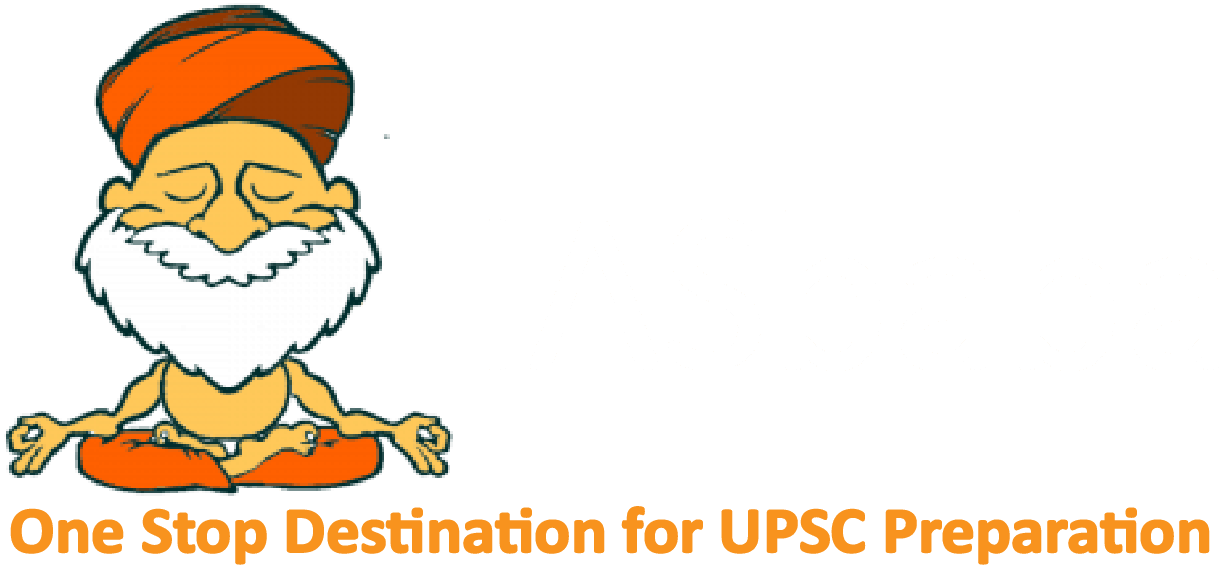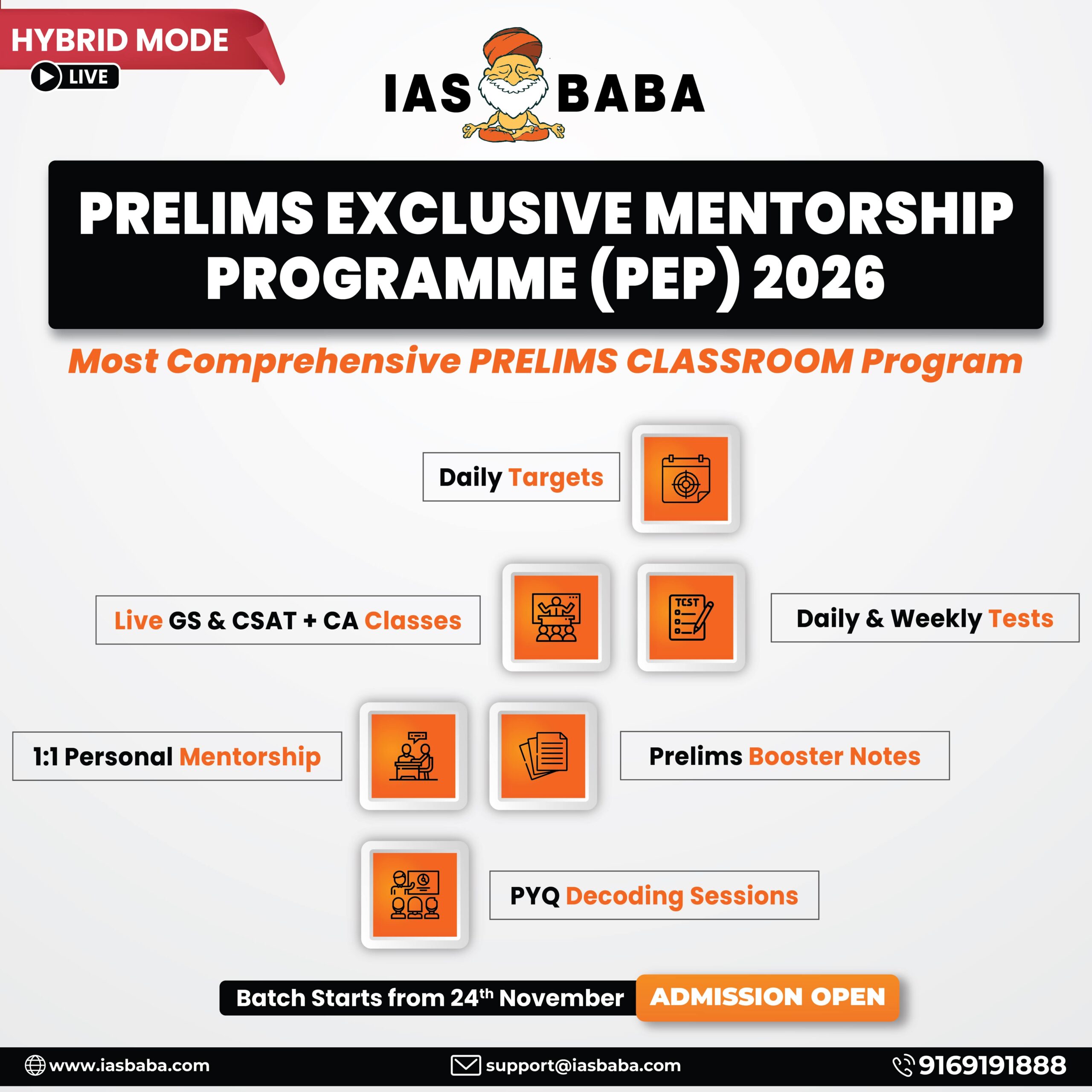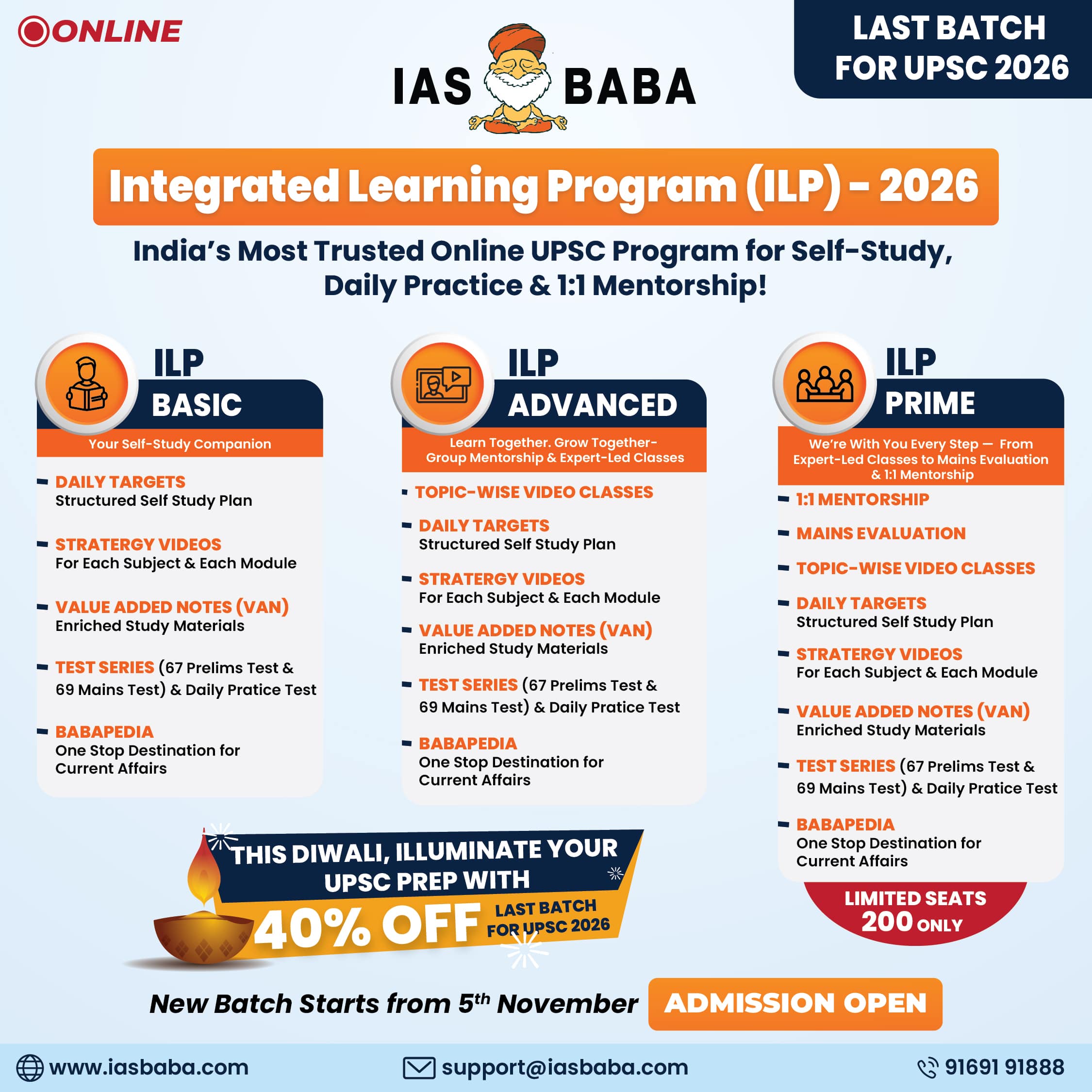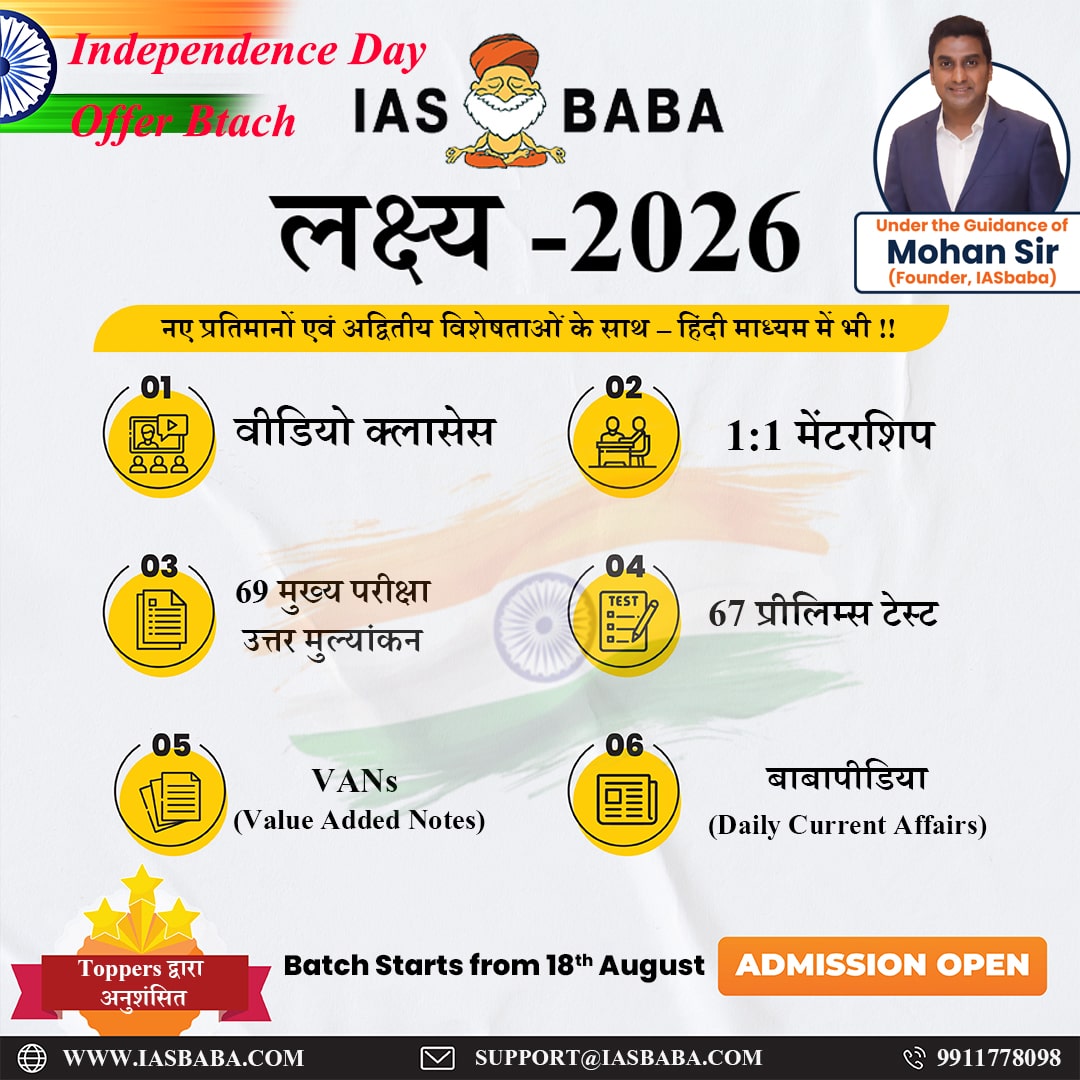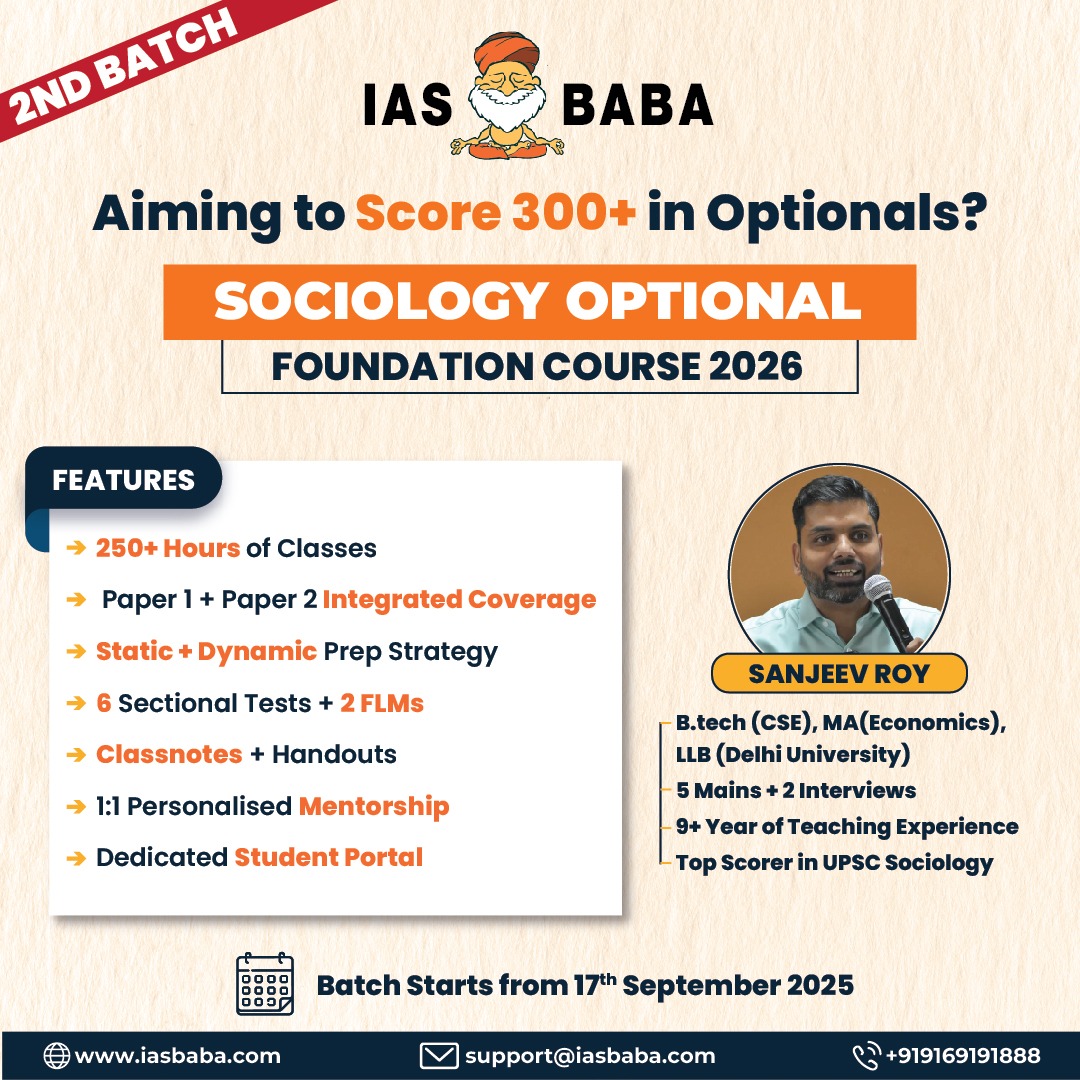IASbaba Daily Prelims Quiz
For Previous Daily Quiz (ARCHIVES) – CLICK HERE
The Current Affairs questions are based on sources like ‘The Hindu’, ‘Indian Express’ and ‘PIB’, which are very important sources for UPSC Prelims Exam. The questions are focused on both the concepts and facts. The topics covered here are generally different from what is being covered under ‘Daily Current Affairs/Daily News Analysis (DNA) and Daily Static Quiz’ to avoid duplication. The questions would be published from Monday to Saturday before 2 PM. One should not spend more than 10 minutes on this initiative.
Gear up and Make the Best Use of this initiative.
Do remember that, “the difference between Ordinary and EXTRA-Ordinary is PRACTICE!!”
Important Note:
- Don’t forget to post your marks in the comment section. Also, let us know if you enjoyed today’s test 🙂
- After completing the 5 questions, click on ‘View Questions’ to check your score, time taken, and solutions.
Test-summary
0 of 5 questions completed
Questions:
- 1
- 2
- 3
- 4
- 5
Information
To view Solutions, follow these instructions:
- Click on – ‘Start Test’ button
- Solve Questions
- Click on ‘Test Summary’ button
- Click on ‘Finish Test’ button
- Now click on ‘View Questions’ button – here you will see solutions and links.
You have already completed the test before. Hence you can not start it again.
Test is loading...
You must sign in or sign up to start the test.
You have to finish following test, to start this test:
Results
0 of 5 questions answered correctly
Your time:
Time has elapsed
You have scored 0 points out of 0 points, (0)
| Average score |
|
| Your score |
|
Categories
- Not categorized 0%
| Pos. | Name | Entered on | Points | Result |
|---|---|---|---|---|
| Table is loading | ||||
| No data available | ||||
- 1
- 2
- 3
- 4
- 5
- Answered
- Review
-
Question 1 of 5
1. Question
-
Q. Consider the following statements regarding Green Crackers:
-
Green Crackers are developed by the Council of Scientific and Industrial Research (CSIR) to reduce emissions of harmful chemicals like barium and aluminum.
-
They emit around 30% less particulate matter and produce less noise compared to conventional fireworks.
-
Only fireworks bearing the CSIR-NEERI logo and QR code are officially recognized as certified green crackers in India.
Which of the statement(s) given above is/are correct?
Correct
-
Solution (c).
Explanation:
- Green crackers were developed by CSIR laboratories, including NEERI, CEERI, and NCL, to curb toxic emissions. They replace banned chemicals such as barium nitrate, aluminum, and potassium chlorate with safer alternatives. Hence Statement 1 is Correct
- Certified green fireworks emit 15–30% less particulate matter (PM10 and PM2.5) and produce lower noise levels, generally staying below 110–125 dB, as per CPCB guidelines. Hence Statement 2 is Correct
The CSIR-NEERI QR code system ensures authenticity and allows traceability of green crackers. Only fireworks bearing this QR code and CSIR-NEERI logo are legally recognized as green fireworks under CPCB and MoEFCC directions. Hence Statement 3 is Correct
Incorrect
-
Solution (c).
Explanation:
- Green crackers were developed by CSIR laboratories, including NEERI, CEERI, and NCL, to curb toxic emissions. They replace banned chemicals such as barium nitrate, aluminum, and potassium chlorate with safer alternatives. Hence Statement 1 is Correct
- Certified green fireworks emit 15–30% less particulate matter (PM10 and PM2.5) and produce lower noise levels, generally staying below 110–125 dB, as per CPCB guidelines. Hence Statement 2 is Correct
The CSIR-NEERI QR code system ensures authenticity and allows traceability of green crackers. Only fireworks bearing this QR code and CSIR-NEERI logo are legally recognized as green fireworks under CPCB and MoEFCC directions. Hence Statement 3 is Correct
-
-
Question 2 of 5
2. Question
Test question
Correct
Test explained
Incorrect
Test explained
-
Question 3 of 5
3. Question
The National Commission for Minorities (NCM) in India is a —
Correct
-
Solution (b).
Explanation:
- The NCM was established in 1992 under the National Commission for Minorities Act, 1992.
- It functions under the Ministry of Minority Affairs.
- The Central Government has notified six religious communities as minorities under Section 2(c) of the Act — Muslims, Christians, Sikhs, Buddhists, Zoroastrians (Parsis), and Jains (Jains added in 2014).
- Composition: Chairperson, Vice-Chairperson, and five Members (at least one woman).
- Nature: Statutory, not constitutional (unlike the National Commission for Scheduled Castes and Scheduled Tribes).
Incorrect
-
Solution (b).
Explanation:
- The NCM was established in 1992 under the National Commission for Minorities Act, 1992.
- It functions under the Ministry of Minority Affairs.
- The Central Government has notified six religious communities as minorities under Section 2(c) of the Act — Muslims, Christians, Sikhs, Buddhists, Zoroastrians (Parsis), and Jains (Jains added in 2014).
- Composition: Chairperson, Vice-Chairperson, and five Members (at least one woman).
- Nature: Statutory, not constitutional (unlike the National Commission for Scheduled Castes and Scheduled Tribes).
-
Question 4 of 5
4. Question
-
With reference to the Multi-Party Interim Appeal Arbitration Arrangement (MPIA) and the original WTO Appellate Body (AB), consider the following statements:
-
While participation in the Appellate Body is automatic for all WTO members, participation in the MPIA is voluntary and limited to those members who have joined it by mutual agreement.
-
Decisions rendered under the MPIA are legally binding on the parties to the dispute in the same manner as Appellate Body rulings adopted by the Dispute Settlement Body.
-
Unlike the Appellate Body, which was a standing institution, the MPIA operates through ad hoc arbitrators appointed case-by-case under Article 25 of the Dispute Settlement Understanding (DSU).
Which of the statement(s) given above is/are incorrect?
Correct
-
Solution (a).
Explanation
- The Appellate Body (AB) was a permanent standing body of seven members under the DSU, applicable to all WTO members.
In contrast, the MPIA (established 2020) is voluntary—only WTO members that opt in (currently around 25) participate. Hence Statement 1 is Correct - Although MPIA awards are binding on the disputing parties that agreed to use it, they are not automatically adopted by the Dispute Settlement Body (DSB) as AB reports are. Their enforceability depends on mutual consent under Article 25, not on the DSU’s automatic adoption procedure. Hence Statement 2 is Incorrect
- The Appellate Body was a standing tribunal with pre-appointed members.
The MPIA, however, relies on ad hoc panels of arbitrators drawn from a pre-agreed pool for each appeal, making it flexible but temporary. Hence Statement 3 is Correct
Conceptual Insight
- Purpose: The MPIA is a stop-gap mechanism to preserve the right to appellate review during the Appellate Body paralysis (since 2019).
- Legal Basis: Article 25 of the DSU (arbitration route).
- Nature: Interim, voluntary, and limited in membership — not a replacement for the AB, but a bridge until full reform is achieved.
Reform goal (MC13 – Abu Dhabi 2024): Restore a fully functional two-tier system by 2024 end.
Incorrect
-
Solution (a).
Explanation
- The Appellate Body (AB) was a permanent standing body of seven members under the DSU, applicable to all WTO members.
In contrast, the MPIA (established 2020) is voluntary—only WTO members that opt in (currently around 25) participate. Hence Statement 1 is Correct - Although MPIA awards are binding on the disputing parties that agreed to use it, they are not automatically adopted by the Dispute Settlement Body (DSB) as AB reports are. Their enforceability depends on mutual consent under Article 25, not on the DSU’s automatic adoption procedure. Hence Statement 2 is Incorrect
- The Appellate Body was a standing tribunal with pre-appointed members.
The MPIA, however, relies on ad hoc panels of arbitrators drawn from a pre-agreed pool for each appeal, making it flexible but temporary. Hence Statement 3 is Correct
Conceptual Insight
- Purpose: The MPIA is a stop-gap mechanism to preserve the right to appellate review during the Appellate Body paralysis (since 2019).
- Legal Basis: Article 25 of the DSU (arbitration route).
- Nature: Interim, voluntary, and limited in membership — not a replacement for the AB, but a bridge until full reform is achieved.
Reform goal (MC13 – Abu Dhabi 2024): Restore a fully functional two-tier system by 2024 end.
-
-
Question 5 of 5
5. Question
-
The “Passport Power Index” (such as Henley Passport Index) ranks passports globally based on:
Correct
-
Solution (d)
Explanation:
- The Passport Power Index — often referred to through ranking systems such as the Henley Passport Index or Arton Capital Passport Index — measures the global mobility of citizens based on how many destinations they can access without obtaining a visa beforehand.
- A higher rank means that passport holders enjoy greater travel freedom — they can either:
- Enter countries visa-free,
- Obtain a visa on arrival, or
- Access using an electronic travel authorization (eTA).
Incorrect
-
Solution (d)
Explanation:
- The Passport Power Index — often referred to through ranking systems such as the Henley Passport Index or Arton Capital Passport Index — measures the global mobility of citizens based on how many destinations they can access without obtaining a visa beforehand.
- A higher rank means that passport holders enjoy greater travel freedom — they can either:
- Enter countries visa-free,
- Obtain a visa on arrival, or
- Access using an electronic travel authorization (eTA).
-
- Current Affairs Quiz, IAS Daily Current Affairs Quiz, IAS UPSC Current Affairs Quiz, IAS UPSC Prelims Quiz, IASbaba's Current Affairs Prelims Quiz, IASbaba's Daily Quiz, IASbaba's UPSC Quiz, Prelims Current Affairs Quiz, UPSC Current Affairs Quiz, UPSC Current Affairs Quiz IASbaba, UPSC Daily Current Affair Quiz, UPSC IAS Daily Quiz

